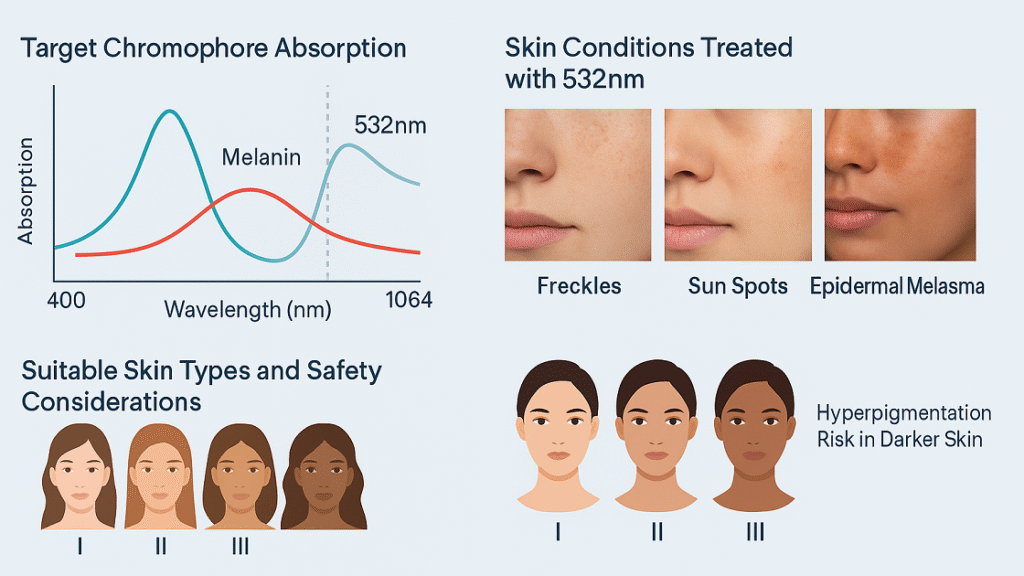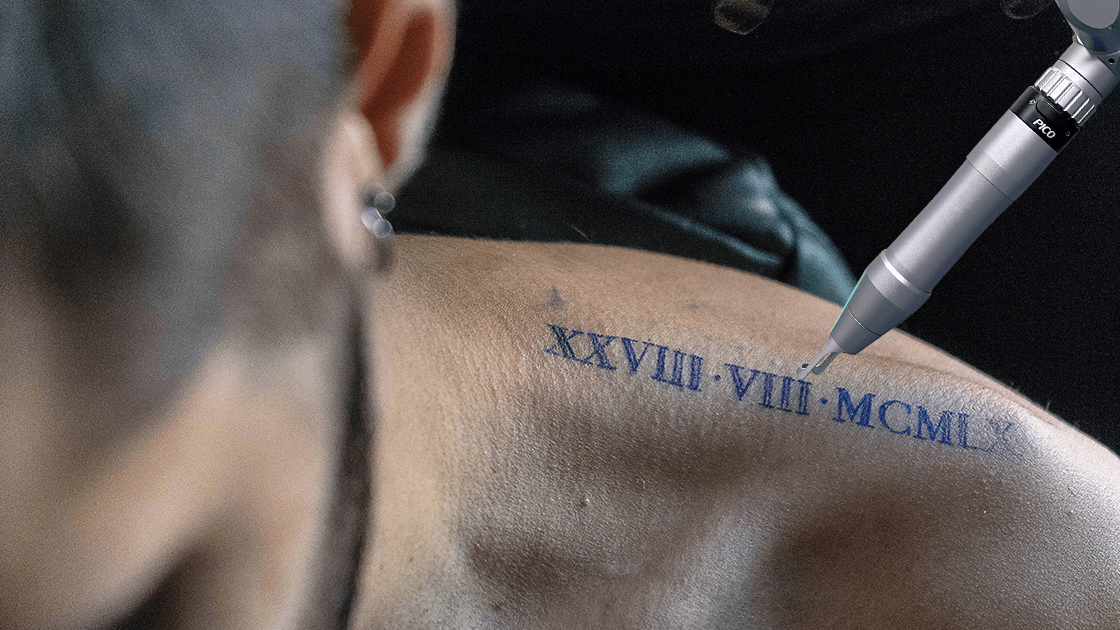1. Introduction: Decoding Pico Laser Wavelengths
In the rapidly evolving landscape of aesthetic dermatology, picosecond laser technology represents a paradigm shift in how we approach pigmentation disorders, tattoo removal, and skin rejuvenation. The precision of ultra-short pulse durations measured in trillionths of a second has revolutionized treatment outcomes while minimizing thermal damage to surrounding tissues. However, the effectiveness of these advanced systems hinges critically on understanding wavelength selection and its clinical implications.
1.1 Why Wavelength Matters in Aesthetic Dermatology
Wavelength selection forms the cornerstone of successful laser therapy, determining which chromophores absorb energy most efficiently. Different wavelengths penetrate to varying depths in the dermis and epidermis, with absorption coefficients varying significantly based on target structures. Melanin, hemoglobin, and tattoo pigments each demonstrate unique absorption spectra, making wavelength choice paramount for optimal clinical outcomes. The photothermal and photomechanical effects generated by picosecond pulses create selective photothermolysis while preserving adjacent tissue integrity. Understanding these fundamental principles enables practitioners to customize treatment protocols for individual patient presentations and skin phototypes.
1.2 Meet the Players: 532nm and 1064nm Pico Lasers
The 532nm and 1064nm wavelengths represent the most widely utilized options in contemporary picosecond laser systems. The 532nm wavelength, generated through frequency doubling of 1064nm diode lasers, provides exceptional absorption in melanin and certain tattoo pigments. Conversely, the 1064nm fundamental wavelength offers deeper penetration with reduced epidermal melanin interference, making it ideal for darker skin types and deep-seated pigmentation. These complementary wavelengths enable comprehensive treatment protocols addressing both superficial and deep chromophore targets. Modern dual-wavelength systems provide practitioners with unprecedented flexibility in customizing treatment approaches for diverse dermatologic conditions.
2. The 532nm Wavelength: Precision for Surface Pigmentation
The 532nm wavelength occupies a unique position in the visible light spectrum, delivering targeted energy absorption by superficial chromophores with minimal deep tissue interaction. This green light wavelength demonstrates exceptional selectivity for melanin and specific tattoo pigments, making it indispensable for treating epidermal pigmentation disorders and certain color tattoos.
2.1 Target Chromophores and Absorption Characteristics
The 532nm wavelength exhibits peak absorption in melanin, with absorption coefficients approximately ten times higher than longer wavelengths. This preferential melanin absorption enables precise targeting of superficial pigmented lesions while minimizing collateral thermal damage. Oxyhemoglobin also demonstrates significant absorption at this wavelength, making it effective for treating vascular components in mixed lesions. The shallow penetration depth of 532nm light concentrates energy in the papillary dermis and epidermis, optimizing treatment of surface pigmentation. Specific tattoo pigments including red, orange, and yellow demonstrate enhanced clearance with 532nm compared to longer wavelengths.
2.2 Skin Conditions Treated with 532nm Pico Laser for Pigmentation
Epidermal melasma responds exceptionally well to 532nm picosecond treatment, with multiple clinical studies demonstrating significant MASI score improvements. Solar lentigines and age spots show rapid clearance due to high melanin content and superficial location. Café-au-lait macules, particularly in lighter skin types, demonstrate excellent response rates with minimal risk of hyperpigmentation. Post-inflammatory hyperpigmentation from acne or other inflammatory conditions benefits from the precise melanin targeting. Ephelides (freckles) typically clear within 1-2 treatment sessions due to their superficial nature and high melanin concentration.
2.3 Suitable Skin Types and Safety Considerations
The 532nm wavelength requires careful patient selection based on Fitzpatrick skin type classification to minimize adverse effects. Skin types I-III generally demonstrate excellent safety profiles with minimal hyperpigmentation risk when appropriate parameters are utilized. Darker skin types (IV-VI) require extreme caution due to high epidermal melanin content, which can lead to competitive absorption and thermal injury. Pre-treatment skin preparation with depigmenting agents may be necessary for darker phototypes to reduce complication rates. Post-treatment hyperpigmentation remains the most significant risk, particularly in patients with darker complexions or recent sun exposure.
2.4 Popular Treatment Applications
Facial rejuvenation protocols utilizing 532nm wavelengths effectively address age-related pigmentation changes and sun damage across the cheeks, forehead, and periorbital regions. Red and orange tattoo removal demonstrates superior efficacy compared to longer wavelengths, often requiring fewer treatment sessions. Benign pigmented lesions including seborrheic keratoses show excellent response when combined with appropriate cooling protocols. Melasma treatment protocols have evolved to incorporate low-fluence 532nm toning techniques, reducing inflammation while maintaining efficacy. Combination approaches using 532nm alongside chemical peels or topical depigmenting agents enhance overall treatment outcomes.

3. The 1064nm Wavelength: The Deep Workhorse
The 1064nm near-infrared wavelength serves as the foundation of most picosecond laser systems, offering deep penetration capabilities with reduced melanin interference. This fundamental Nd:YAG wavelength provides versatility across diverse skin types and chromophore targets, making it the workhorse of contemporary aesthetic laser therapy.
3.1 Longer Penetration, Broader Application
The 1064nm wavelength penetrates significantly deeper than shorter wavelengths, reaching the mid-to-deep dermis where many chronic pigmentation disorders originate. The wavelength of 1064nm has lower absorption in melanin and is, therefore, more gentle, especially on darker skin types. This reduced melanin competition allows for higher fluences in darker phototypes while maintaining safety profiles. The deeper penetration enables treatment of dermal pigmentation that remains inaccessible to shorter wavelengths. Collagen remodeling effects from 1064nm treatment contribute to overall skin texture improvement and rejuvenation benefits beyond pigment removal.
3.2 1064nm Pico Laser for Tattoo Removal and Deep Pigmentation
Black and dark blue tattoo pigments demonstrate exceptional absorption at 1064nm, making it the gold standard for removing these common colors. The efficacy of the 1064 nm picosecond laser is significantly better than the other studied lasers for black tattoos. Dermal melanosis conditions including nevus of Ota and Hori’s nevus respond favorably to 1064nm treatment protocols. Deep melasma components that resist superficial treatments often clear with repeated 1064nm sessions at appropriate fluences. Carbon tattoos and traumatic tattoos from accidents or injuries typically require 1064nm wavelengths for complete clearance. Professional tattoos with dense black pigmentation may require combination protocols using both 1064nm and adjunctive wavelengths.
3.3 Compatibility with All Skin Types
The 1064nm wavelength demonstrates excellent safety across all Fitzpatrick skin types due to reduced epidermal melanin absorption. Darker skin types (IV-VI) tolerate 1064nm treatments with minimal hyperpigmentation risk when appropriate parameters are selected. The lower melanin competition allows for therapeutic energy delivery without compromising epidermal integrity. Asian populations with mixed dermal-epidermal melasma benefit particularly from 1064nm toning techniques that avoid epidermal disruption. Post-inflammatory hyperpigmentation rates remain significantly lower with 1064nm compared to shorter wavelengths in susceptible patients.
3.4 Popular Treatment Applications
Comprehensive tattoo removal protocols rely heavily on 1064nm wavelengths for black, blue, and dark green pigments across multiple treatment sessions. Fractionated non-ablative 1064 nm picosecond laser was effective in treatment of melasma and skin rejuvenation. Melasma treatment using low-fluence 1064nm toning has gained popularity due to reduced inflammation and exacerbation risks. Skin rejuvenation protocols combine pigment removal with collagen stimulation effects for comprehensive anti-aging benefits. Carbon laser peels utilizing 1064nm wavelengths provide immediate skin brightening with minimal downtime. Age-related pigmentation including solar lentigines responds well to 1064nm treatment with reduced complications in mature skin.
4. Wavelength Comparison Table: 532nm vs. 1064nm
Understanding the distinct characteristics and applications of each wavelength enables informed treatment planning and optimal patient outcomes. The following comparative analysis highlights key differences in penetration depth, target chromophores, and clinical applications.
4.1 Side-by-Side Analysis
| Characteristic | 532nm Wavelength | 1064nm Wavelength |
| Penetration Depth | Superficial (epidermis to papillary dermis) | Deep (mid to deep dermis) |
| Primary Chromophore | Melanin, oxyhemoglobin | Water, collagen, melanin |
| Melanin Absorption | Very high | Moderate |
| Skin Type Compatibility | Types I-III (caution IV-VI) | All types I-VI |
| Pigmentation Target | Epidermal melasma, solar lentigines | Dermal melasma, deep pigmentation |
| Tattoo Colors | Red, orange, yellow, purple | Black, blue, dark green |
| Treatment Frequency | Every 4-6 weeks | Every 6-8 weeks |
| Pain Level | Moderate to high | Low to moderate |
| Downtime | 3-7 days | 1-3 days |
| Complication Risk | Higher in dark skin | Lower overall |
4.2 Choosing the Right Wavelength: Factors to Consider
Patient skin type assessment using the Fitzpatrick classification system guides initial wavelength selection, with 532nm reserved for lighter phototypes and 1064nm suitable for all skin types. Pigmentation depth evaluation through dermoscopy or specialized imaging helps determine whether superficial or deep-penetrating wavelengths will prove most effective. Lesion characteristics including color, density, and distribution patterns influence wavelength choice and treatment parameters. Previous treatment history and patient response to specific wavelengths inform protocol adjustments and combination approaches. Seasonal considerations and sun exposure patterns affect treatment timing and wavelength selection to minimize complications.
5. Real Patient Cases and Clinical Evidence
Clinical evidence supporting wavelength-specific applications continues to grow, with numerous studies demonstrating the efficacy and safety of targeted picosecond laser protocols. Real-world patient cases provide valuable insights into treatment outcomes and protocol optimization strategies.
5.1 Case 1: Treating Epidermal Melasma with 532nm
A 42-year-old Fitzpatrick type II female presented with bilateral facial melasma of 8 years duration, characterized by confluent brown patches across the malar regions and upper lip. Dermoscopic examination revealed primarily epidermal pigmentation with minimal dermal involvement. Treatment protocol consisted of 532nm picosecond laser at 0.8-1.2 J/cm² with 2mm spot size every 4 weeks for 6 sessions. MASI scores decreased from 12.4 to 3.2 over the treatment period with no adverse effects. Patient reported 85% satisfaction with pigment clearance and improved skin texture. Maintenance treatments every 3 months sustained long-term results with continued sun protection compliance.
5.2 Case 2: Tattoo Removal with 1064nm Laser
A 28-year-old male with Fitzpatrick type IV skin presented for removal of a professional black tribal tattoo covering 15cm² on the upper arm. Initial assessment revealed dense black pigmentation with sharp borders typical of professional tattoos. Treatment utilized 1064nm picosecond laser at 1.5-2.0 J/cm² with 3mm spot size every 8 weeks. After 8 treatment sessions, 95% pigment clearance was achieved with minimal scarring or texture changes. The patient experienced moderate discomfort during treatments but required no topical anesthesia. Complete healing occurred within 1-2 weeks following each session with appropriate aftercare protocols.
5.3 Dermatologist Insights and Protocol Preferences
Leading dermatologists emphasize the importance of proper patient selection and realistic expectation setting before initiating picosecond laser treatments. Treatment parameters must be individualized based on skin type, lesion characteristics, and patient tolerance levels. The picosecond laser was less painful during the procedure, with a lower potential risk of exacerbation of melasma. Combination protocols utilizing multiple wavelengths often produce superior results compared to single-wavelength approaches. Post-treatment care protocols including sun protection, gentle skincare, and appropriate follow-up significantly impact long-term outcomes. Patient education regarding realistic timelines and potential side effects improves compliance and satisfaction rates.
6. Combination Approaches: When 532nm and 1064nm Work Together
The synergistic effects of dual-wavelength picosecond protocols have revolutionized treatment outcomes for complex pigmentation disorders and comprehensive facial rejuvenation. Strategic combination approaches target multiple chromophores simultaneously while optimizing safety profiles.

6.1 Layered Pigmentation Protocols
Mixed melasma presentations with both epidermal and dermal components benefit significantly from sequential dual-wavelength treatments. Initial sessions utilizing 1064nm address deep dermal pigmentation without epidermal disruption, followed by 532nm treatments targeting superficial components. This layered approach minimizes inflammatory responses while maximizing pigment clearance across all skin layers. Treatment intervals between wavelengths typically range from 2-4 weeks to allow complete healing and minimize complications. Progressive fluence increases with each wavelength optimize treatment outcomes while maintaining patient comfort and safety.
6.2 Full-Face Skin Rejuvenation Using Dual-Wavelength Pico Laser
Comprehensive facial rejuvenation protocols incorporate both wavelengths to address multiple signs of photoaging simultaneously. The 1064nm wavelength provides collagen stimulation and deep pigment clearance, while 532nm targets superficial sun damage and fine textural irregularities. Treatment mapping divides facial regions based on predominant concerns, with T-zone areas often requiring 532nm for sebaceous gland regulation and cheek areas benefiting from 1064nm for deeper rejuvenation. Fractional delivery systems enhance treatment versatility by providing controlled thermal zones with preserved healing bridges. Patient satisfaction rates exceed 90% when comprehensive protocols address multiple aging concerns simultaneously.
6.3 Optimizing Outcomes and Minimizing Risks
Pre-treatment assessment protocols evaluate skin condition, phototype, and medical history to customize dual-wavelength approaches appropriately. Cooling systems and topical anesthetics minimize patient discomfort during combination treatments while maintaining treatment efficacy. Post-treatment care protocols emphasizing gentle cleansing, moisturization, and strict sun protection optimize healing and prevent complications. Treatment intervals between combination sessions typically extend to 6-8 weeks to allow complete tissue recovery and remodeling. Regular follow-up assessments enable protocol adjustments based on individual patient responses and evolving treatment goals.
7. FAQs About Pico Laser Wavelengths
It depends on your skin type, pigmentation depth, and goals. 532nm suits superficial issues in light skin, while 1064nm is better for deeper concerns and darker skin. A dermatologist’s evaluation is key.
Yes, dual-wavelength treatments are common, especially for mixed-depth pigmentation. However, settings must be tailored to avoid irritation or over-treatment.
Black tattoos may need 6–10 sessions with 1064nm. Colored tattoos often require more, especially with 532nm. Professional tattoos usually take longer to remove.
Yes, darker skin (Types V–VI) should generally avoid 532nm due to higher pigment risks. 1064nm is safer across all skin types with proper care.
532nm may cause visible effects and 3–7 days of downtime. 1064nm usually has minimal side effects and 1–3 days of recovery.
Not all. They’re effective for many pigment issues, but conditions like drug-induced pigmentation may resist treatment or require alternative options.
8. Conclusion: Choosing the Right Pico Wavelength for Your Skin Goals
Choosing between 532nm and 1064nm wavelengths is key to effective and safe treatment. The 532nm is ideal for superficial pigmentation and red or light-colored tattoos, especially in lighter skin types. In contrast, the 1064nm wavelength penetrates deeper and is safer for all skin types, making it suitable for dermal pigmentation and black ink tattoos. Modern treatments often combine both wavelengths to address mixed pigment types, improving results while maintaining safety. Patient-specific factors—like skin type, pigmentation depth, and treatment goals—must guide wavelength selection. Realistic expectations, proper pre-treatment care, and accurate parameter settings are essential for optimal outcomes. As technology evolves, tools like AI and imaging may enhance real-time decision-making, but the basics of wavelength-specific targeting still matter most. Ultimately, personalized laser therapy rooted in a solid understanding of both wavelengths ensures safer, more precise, and more effective aesthetic outcomes.
9. References and Clinical Sources
- Pico Laser for Tattoo Removal: What Colors Respond Best?
- Why DualPico Laser Excels at Treating Melasma
- Skin Rejuvenation
- DualPico Laser Revolutionizes Skincare
- DualPico Laser: Precision in Beauty, Power in Results!
Prospective Comparison Study of 532/1064 nm Picosecond Laser vs 532/1064 nm Nanosecond Laser in the Treatment of Professional Tattoos in Asians







